UNDER THE SKIN: MAZDA RX-7 SPORTS SEDAN

The ultimate father-son project and one of the fastest sports sedans in the country, however this Mazda RX7 also follows some ‘old school’ principles as Heath McAlpine discovers.
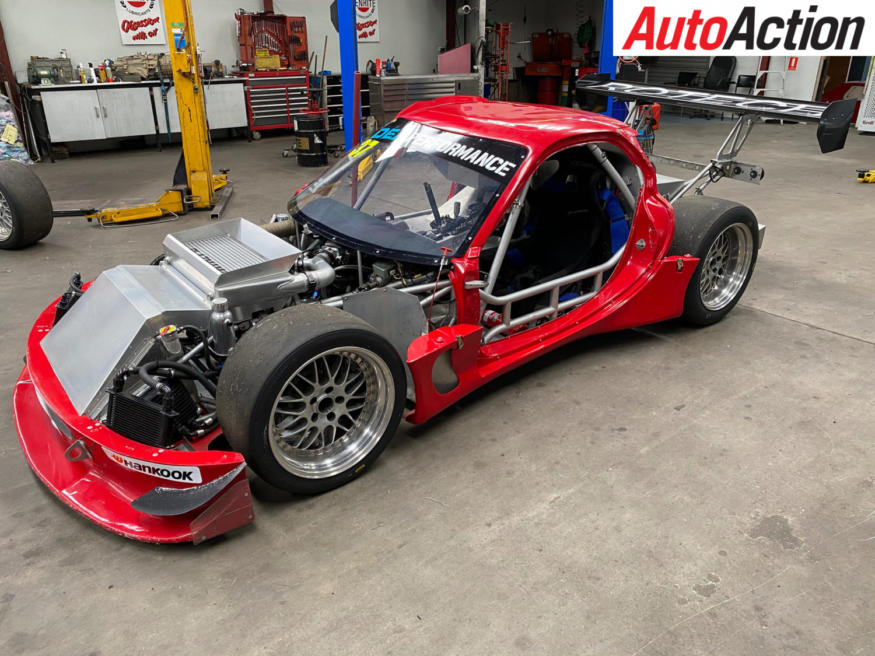
Inspired to step up a level after writing off their production-based Mazda RX-7 sports sedan, Tasmanians Laurie and Alex Williams took five-years to build its replacement.
This new space-frame RX-7 is the first of its kind built by the father and son team, and has since become one of the fastest sport sedans in the country.
Surprisingly for such an advanced vehicle, the design method used to create it is rather old school in the way that Computer Aided Design was actually not used in its creation.
Although not an outright entry during its initial campaigns, various upgrades including a large turbocharger combined with its 50-50 weight distribution has made it into an absolute weapon in the Sports Sedan category.
Son Alex drives the RX-7 and in its limited mainland events is a regular thorn in the side of the class veterans, though this was not the initial aim for the build.
“It was a big project in the making, it took us five years to do together,” said Alex Williams.
“The thing for us was we didn’t realise how long it would take. When you’re making every bracket, it just takes so long. It wasn’t so much about upgrading as we went, it was more about using the parts that we had, but to do it to a standard we could achieve that we thought was high.
“Our aim with the car was never to be a national contender, it was built as a state level car to the budget that we had.
“What we’ve ended up with works well and much better than we ever anticipated.”
While CAD is heavily influencing new sports sedan builds, that doesn’t mean that crafting the design of a chassis without CAD has been lost, as proven by the example adorning these pages.
“The design for the suspension geometry and the chassis was all completed by dad in his head,” Williams told Auto Action. “We designed and built as we went.
“Dad did up a 2D cardboard physical model to scale looking at camber change and experimenting with different length arms. He’d never built a space-frame car before so it was a big experiment and based on what he’d learnt over the years through research.”
Due to the construction and design method there was considerable experimentation, which led Williams Snr to restart the whole manufacture of the front-end chassis section after the initial build failed to meet his expectation.

Recent upgrades to the RX-7 means the project is still educating the Williams pair, especially with the addition of a Garrett GTX45 Turbo.
“We started with a 20B peripheral port non-turbo engine, which may have made 280kW on a good day,” said Williams. “We have the turbo engine in the car now, which we did a year ago and makes so much more than it ever has before.
“Getting on top of those sorts of changes, there’s a bit in that. We’re learning every time we race; we look at the data and adjust things, trying to make it work as a package. We’re not focusing on making more power than others or any one thing, it’s more about making a better package.
“The drivers that win have the best package and make it to the end of the race.”
An intriguing aspect of this RX-7 is the location of the turbo, which is found in an unlikely area.
“The turbo is located down the back, it sits directly underneath the main hoop of the roll cage,” explained Williams. “We did that because it’s a bit better for the exhaust, there’s no silly angles going into the turbo, it’s straight and gives us a good path into the wastegate.
“There’s a big pipe coming out of the middle of the car and out of the passenger side window. That’s where the air goes into the turbo, which is one of the defining features of the car in its latest phase.
“This makes the exhaust very short, it’s only about 300mm long.”
Heat and noise now two problems that have been encountered.
“Packaging is important. There’s so much heat going on inside that trying to get a compromise between a lot of things, it’s hard to decide where to put it and how to duct everything,” Williams explained.
“That’s the beauty of Sports Sedans, everybody comes up with their own solutions to these problems.
“We’ve gone to a fair bit of trouble to try and insulate the inlet pipe from the turbo to the engine. It runs parallel to the exhaust, up the tunnel down the side of the car.”
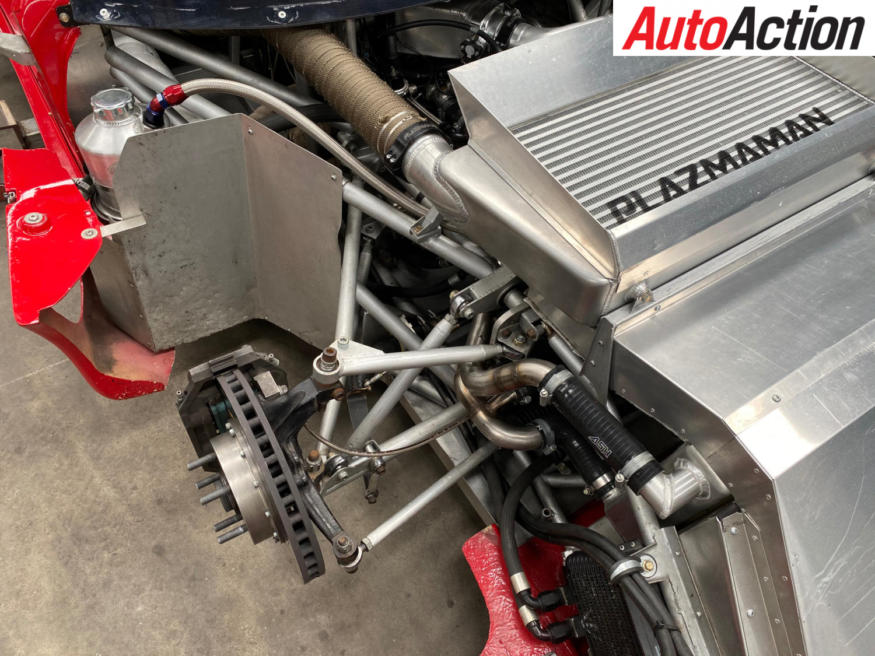
A custom Plazmaman intercooler is fitted at the front, perfectly placed in among the tanks, inlets and outlets.
“The intercooler is at the front of the car so it runs out of the turbo up to the front, through the intercooler and into the engine,” Williams said.
“It is very well ducted and the inlet temperatures that we’ve seen are pretty good, there even less than we expected. From that side of things, it seems to work pretty well, it’s not something that we knew the answer to, it was a bit of a lucky dip.”
The heart of the RX-7 is a 20B triple-rotor engine, which remains surprisingly unmodified and utilises many stock components, despite the high intensity environment it performs in.
“It’s a 20B long engine, so it has the thick centre plate,” Williams said. “As an engine it’s fairly standard, it’s got Mazda 2mm apex seals just with an extend port on the inlet and inlet manifold we made ourselves.
“It’s a standard crank, rotors, endplates, there’s no billet parts. Really, the only modifications are a bit of clearancing and a tidy up of the inlet ports, but other than that it’s a pretty standard engine.”
The radiator is an off the shelf item, while the bellhousing is made out of magnesium, but based on the Mazda original.
Sequential gearbox systems are now a staple of Sports Sedan competition as is a paddleshift, but Williams’ use a Holinger H6S H-Pattern dogbox using a Tilton triple-plate 5 ½ inch clutch.
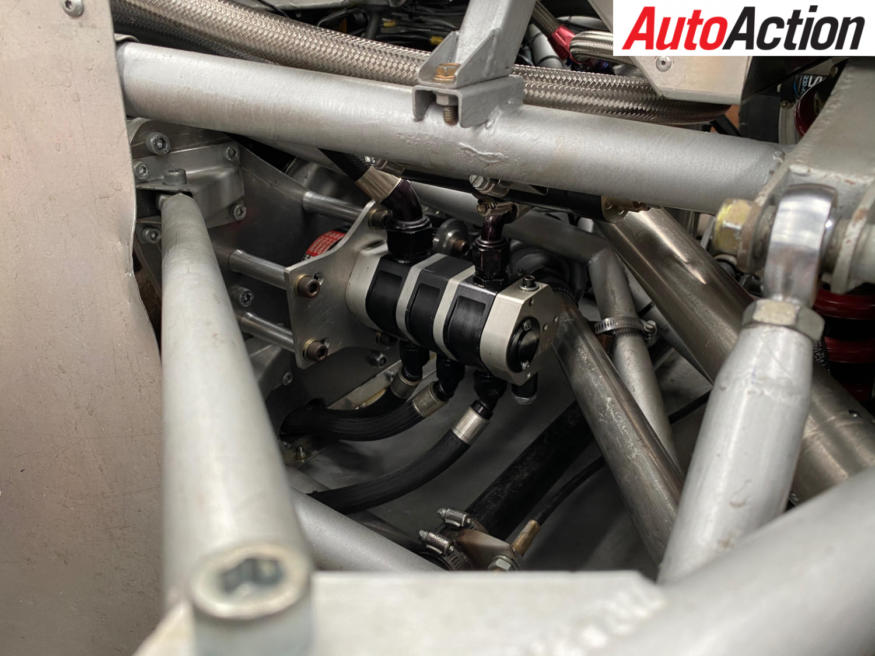
An upgrade is scheduled starting with the transmission and a move away from the Mazda RX-7 FD diff, as the gearing is a limiting factor.
“Not sure about paddleshift, but I believe there is a whole lot of added complications and I’m not sure it would make me any faster,” Williams reasoned.
“I think a sequential is definitely a step up. We have a gear ratio problem at the moment where the tallest diff in the Mazda range that fits is a 3.9, which is an FD automatic crown wheel and pinion and we have a 1:1 sixth gear.
“It means we’re pretty short on ratios at the moment. At Phillip Island last year in qualifying we did 294kmh down the straight on the rev limiter!
“Although the FD diff has been great and I haven’t had any problems with it due to its strength, it’s probably borderline.
“Down the track we need to look at a sequential Holinger with an over-drive sixth, or going towards an Albins transaxle and modifying the rear-end to make everything fit.”
Penske three-way adjustable shocks are combined with Eibach springs, while an inbound rocker suspension system is featured all-round with an independent rear-end. Axles are also a Mazda product, while custom brake hats are mated to hubs also found in the Japanese manufacturer’s catalogue.

An anti-roll bar and sway bar were designed in-house, while blade adjusters for each were supplied by Mitchell Race Xtreme in New Zealand, and onboard levers beside the gearstick enable changes to be made on the fly.
“When we first built the car, we came from a floor pan chassis class and had always had those sorts of cars, so when we went to the space-frame car the alignment was a fair bit different than we thought originally,” recalled Williams.
“The result is we are running a lot less camber all around and different levels of toe front and back. We learnt about this by looking at the tyre wear and how the car felt. In recent times the shock travel sensors, for me looking at what the suspension is doing and relating that to what I was feeling in the car, really helped in getting a direction on the geometry and the shock settings.”
So, what are the results of this set-up? According to Williams it’s a work in progress as the aim is to increase the RX-7’s corner speeds to bridge the gap that remains to the leading competitors.
“It’s very flat, it doesn’t roll a lot,” Williams described. “When we designed the car, we’ve tried to make the shock do as much work as possible so it has a fair bit of shock travel compared to the wheel movement.
“It was a design that dad came up with early on and the rockers are designed to enhance that. It’s very direct in the steering.”
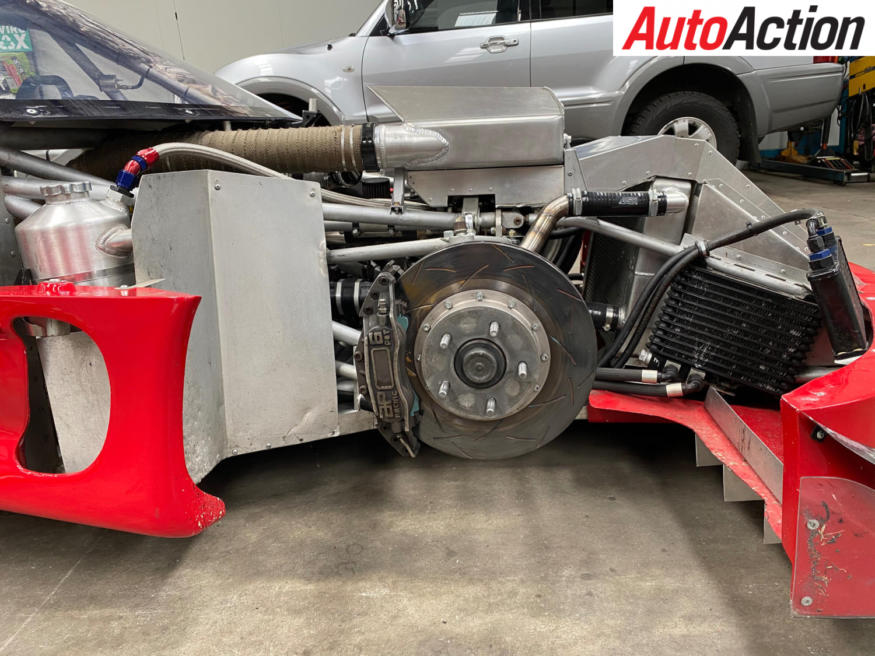
Brakes are according to Williams ‘pretty small’ with 320x32mm front and 310×20 rear rotors, combined with AP 6-pot calipers front and rear, which were components from the written off RX-7. The brake lines are a stainless hard-line component braided on the ends, while after rigorous testing of various brands of brake pads, Williams chose the Project Mu items as his preferred option.
“I found that they have quite a good bite compared to some other pads we used to run,” Williams said. “Project Mu has definitely become a favourite of mine.”
Telemetry and data logging are provided by a mixture of software. An AIM MXL dash and data logger is combined with a MoTeC M800 ECU, thanks to both systems being user friendly in different ways.
“We look at data through the MoTeC logging software and data analysis as well as the AIM,” Williams summed up. “Not that long ago, we put some shock travel sensors on and that all runs through the AIM dash so we look at data through both platforms.
“I found that the AIM software has some stuff that is easier to do than the MoTeC system, because a lot of it comes set-up such as track mapping, sector times, shock analysis and the like.
“For a driver tool, I use the AIM a lot more than the MoTeC, but for systems on the car and monitoring everything, it’s a bit of mixture of both.”
A cold drawn welded unalloyed carbon steel cage protects Williams, while chrome-moly is featured throughout the spaceframe chassis.

Many of the interior components are from the previous written off chassis, including the Cobra head restraint seat, while a Sparco steering wheel and Tilton brake bias adjuster sit in front, as does a Tilton pedal box. A fire extinguisher is placed under Williams legs in case the danger of fire occurs.
The fuel tank is also a unique item to the RX-7 as it has had to be modified from its original specifications due to the turbo addition and the length of races it now competes in.
“When we built the car with the naturally aspirated engine, we just had a fuel tank in there that was fairly borderline on capacity to do the longer style races, such as the 50K Plate,” Williams explained.
“When the turbo was introduced, we changed it to run on E85 [before we used just 98 pump fuel] so we had to have a lot more fuel. It’s got an extension on the extension of the original fuel tank to get to capacity.
“Another interesting thing about that is it has a gravity fed surge tank so the fuel drains into a surge tank, which is on the bottom of the original tank and it’s got a lip on it allowing the fuel to get in, but not escape. It then has two Bosch 044 pumps to the engine and six Bosch 2000CC injectors.”
The body is obviously an FD RX-7, one of the more popular styles in sports sedan racing.
In fact, this body was created by Norm Lee from Victoria and molds were bought by Williams in partnership with former fellow competitor Barny Newbound.
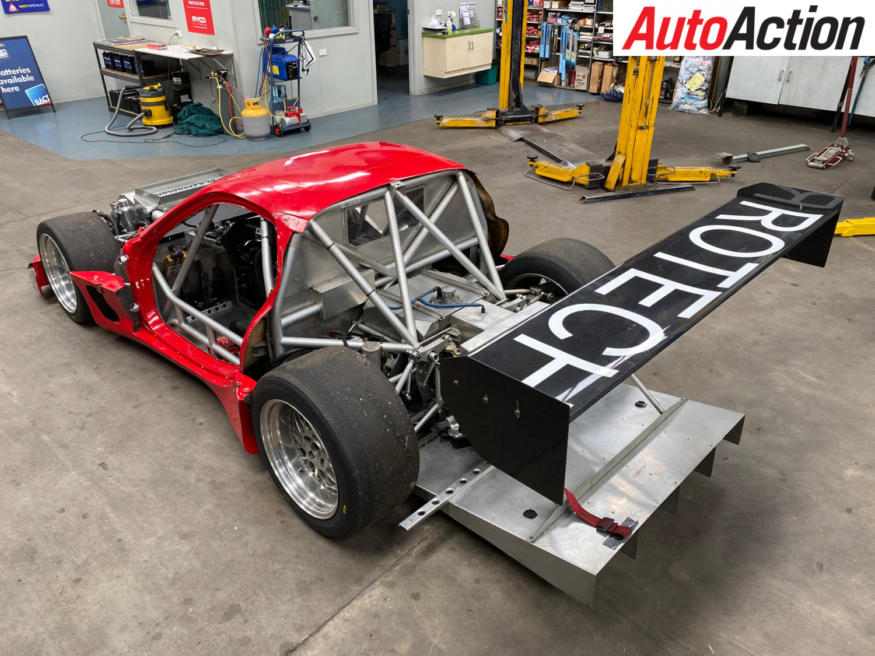
All that has been changed is due to the ducting in the front splitter and the addition of canards, while the rear diffuser is an in-house item and the rear wing was produced by Scott Beaton from Aero Design.
Hiding underneath the wide guards are wheels with Whitehorse inner and outer rim sections mated to a Simmons centre, while Kumho has taken over the control tyre rights of Sports Sedans, so a 280/650 tyre fits around the 18×11 inch front wheels and 310/710s wrap the 18×12 inch rears, which is a recent upgrade.
“We went to the bigger tyre on the back and that really helped the drive of the car,” Williams enthused. “It’s pretty neutral in the corners now, we used to have a little bit of understeer in the corners, which we managed to get on top of.”
As the environment in which this RX-7 competes in is very adverse, the servicing is rigorous with the team learning that the engine ideally needs to be taken out every three meetings for a freshen up, after previously stretching it out to five events.
A gearbox lasts a season before it needs a going over, the diff is pulled out usually after each meeting to check wear, especially if it competes at Winton and Wakefield Park, when the shorter diff is required.
This father-son project gone wild has been an enjoyable process, and one that Williams Junior hopes to undertake again with his father in the future. Next time, though, a CAD will be used for the design process.
“I don’t think so,” replied Williams when asked if he’d follow the same build process again.
“I’d try and use some CAD to at least get the chassis, engine and driveline package designed first.
“I believe the more sports sedans you build the better you get, as there are so many little things you find along the way. If we were going to do it again, it would be a different car for sure.”

Engine – 20B triple-rotor, Garrett GTX45 turbo, Plazmaman intercooler, standard Mazda crank, rotors and endplates, dry sump, magnesium bellhousing
Fuel System – Gravity-fed surge tank, two Bosch 044 pumps, six Bosch 2200CC injectors
Drivetrain – Holinger HS6 H-Pattern dogbox, Mazda FD RX-7 diff, Tilton triple-plate 5 ½ inch clutch, Mazda axles
Brakes:
Six-pot AP calipers, braided brake lines, Project Mu pads, Tilton brake-bias adjustor
Rotors F: 320x32mm
R: 310x20mm
Suspension:
Penske three-way adjustable shocks, inbound rocker suspension system, independent rear push-rod, Mazda hubs, custom hats, bespoke anti-roll and sway bars with Mitchell Race Xtreme blade adjustor and interior levers
Body – Fibreglass Mazda FD RX-7 body, space-frame chassis, Aero Design rear wing, in-house designed rear diffuser
Wheel and Tyres:
Whitehorse inners and outers combined with Simmons centre wheels, Kumho control tyre
F: 18×12 325/710
R: 18×11 280/650
Interior – Cobra head restraint seat, Sparco steering wheel, Willans belts, Tilton pedal box
Dimensions:
Length: 4485mm
Width: 1960mm
Wheelbase: 2425mm
Weight: 1125kg with driver


